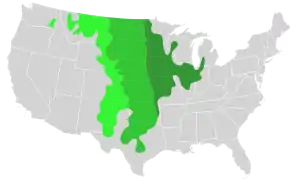Mixed grass prairie
A mixed-grass prairie is an ecotone located between the tallgrass prairies and shortgrass prairies. The mixed-grass prairie is richer in ecological diversity than either the tall- or shortgrass prairie. The mixed-grass prairie occurs in the central plains portion of the Great Plains, varying in width from central Texas in the United States up into southeastern Manitoba, Alberta and Saskatchewan in the northern mixed grasslands of Canada.[1]

Mixed grass prairie around the Afterbay near Fort Smith, Montana

Mixed grass prairie in relation to the Great Plains
Mixed grass prairie
See also
References
- G. E. Wickens: Ecophysiology of economic plants in arid and semi-arid lands p.76
External links
- "Badlands Mixed-grass Prairies". U.S. National Park Service ~ Prairie Ecology of the Badlands. U.S. Department of the Interior.
- "Central and Southern Mixed Grasslands". Terrestrial Ecoregions - Temperate Grasslands, Savannas, and Shrublands. World Wildlife Fund (WWF).
- "Mixed-grass Prairie - Missouri Coteau". North Dakota Game and Fish Department. State of North Dakota.
- "Sagebrush Steppe And Mixed Grass Prairie". U.S. National Park Service - Bighorn Canyon National Recreation Area. U.S. Department of the Interior.
- "Wyoming Native Plants Program". U.S. Bureau of Land Management ~ Wyoming. U.S. Department of the Interior.
This article is issued from Wikipedia. The text is licensed under Creative Commons - Attribution - Sharealike. Additional terms may apply for the media files.